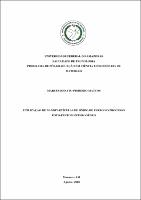| ???jsp.display-item.social.title??? |


|
Please use this identifier to cite or link to this item:
https://tede.ufam.edu.br/handle/tede/6687| ???metadata.dc.type???: | Dissertação |
| Title: | Utilização de Nanopartículas de Óxido de Ferro no processo Foto-Fenton heterogêneo |
| ???metadata.dc.creator???: | Mattos, Marcus Renato Pinheiro  |
| ???metadata.dc.contributor.advisor1???: | Pocrifka, Leandro Aparecido |
| ???metadata.dc.description.resumo???: | O despejo de poluentes orgânicos tanto em solos da superfície terrestre como em águas residuais é prejudicial à saúde humana e ao meio aquático. Nessa conjuntura, os Processos Oxidativos Avançados (POA’s) são opções atrativas, pois possuem na sua essência a formação de radicais hidroxila (HO•) que atuam como oxidantes na eliminação desses contaminantes. Os POA’s oferecem diferentes rotas, dentre essas, pode-se destacar o processo Foto-Fenton heterogêneo perante o emprego de um semicondutor no estado sólido, tal como o óxido de ferro na fase hematita (α - Fe2O3) em combinação com o peróxido de hidrogênio (H2O2) sob irradiação à luz visível. Dessa forma, o objetivo desse trabalho foi sintetizar nanopartículas de óxido de ferro (Fe2O3) pelo método dos precursores poliméricos (Pechini), variando a temperatura de calcinação, e caracterizá-las por meio das técnicas de Termogravimetria (TGA/DTG), Fluorescência de Raios X (FRX), Difratometria de Raios X (DRX), Microscopia Eletrônica de Varredura (MEV), Espectroscopia na região do Infravermelho com Transformada de Fourier (FTIR) e Espectroscopia de Reflectância Difusa (ERD). Assim como, investigar a degradação do corante Azul de Metileno (AM) através do processo Foto-Fenton heterogêneo por intermédio de uma lâmpada de Xenon 35W, e um béquer de vidro contendo o corante AM a 10 mg.L -1 , adicionando H2O2 em torno de 0 a 1% dentre o volume da solução de AM, além de acrescentar 20 mg das amostras sintetizadas no sistema que se encontrava sob agitação constante. Por conseguinte, foram retiradas alíquotas em intervalos regulares para a realização de análises por meio da técnica espectrofotômetria UV-Vis. Assim, por meio da técnica de DRX foi confirmada a presença da fase hematita (α - Fe2O3) nas amostras obtidas. Além disso, foi constatado que utilizando 200 microlitros de H2O2 no sistema, alcançou-se uma maior eficiência para todas as amostras, de forma que aquela calcinada a 1000 ºC degradou 91,764% do corante AM no período de 1 hora. Dessa maneira, os resultados indicaram a viabilidade do método de Pechini para a obtenção de nanopartículas de α - Fe2O3 e o seu emprego no processo FotoFenton heterogêneo a luz visível, visto que essa representa 46% da irradiação solar na superfície terrestre, o que torna atrativo a sua aplicação para a degradação de contaminantes orgânicos em águas residuais. |
| Abstract: | The discharge of organic pollutants in land surface and wastewater soils is harmful to human health and the aquatic environment. At this juncture, Advanced Oxidative Processes (AOP’s) are attractive options, since they have in their essence the formation of hydroxyl radicals (HO•) that act as oxidants in the elimination of contaminants. The AOP’s offer different routes, among them, it is possible to highlight the heterogeneous Photo-Fenton process when using a semiconductor in the solid state, such as iron oxide in the hematite phase (α-Fe2O3) in combination with hydrogen peroxide (H2O2) under visible light irradiation. Thus, the objective of this work was to synthesize iron oxide (Fe2O3) nanoparticles by the polymer precursors method (Pechini), varying the calcination temperature, and characterize them using the techniques of Thermogravimetry (TGA / DTG), X-Ray Fluorescence (FRX), X-Ray diffractometry (XRD), Scanning Electron Microscopy (SEM), Fourier Transform Infrared Spectroscopy (FTIR) and Diffuse Reflectance Spectroscopy (DRS). As well as investigating the degradation of the Methylene Blue (MB) dye through the heterogeneous Photo-Fenton process by means of a 35W Xenon Lamp, a glass beaker containing 40 mL of the MB dye at 10 mg.L-1 , adding H2O2 around 0 to 1% of the volume of the MB solution, beside that to adding 20 mg of the samples synthesized in the system that was under constant stirring. Therefore, aliquots were taken at regular intervals for analysis on the UV-Vis spectrophotometer. Thus, by means of the XRD technique, the presence of the hematite (α - Fe2O3) phase was confirmed in the samples obtained. In addition, it was found that using 200 microliters of H2O2 in the system, higher efficiency was achieved for all samples, so that the calcined at 1000 °C degraded 91.764% of the AM dye within 1 hour. Thus, the results indicated the feasibility of the Pechini method to obtain α - Fe2O3 nanoparticles and their use in the heterogeneous Photo - Fenton process in the visible light, since this represents 46% of the solar irradiation on the terrestrial surface, which makes its application attractive for the degradation of organic contaminants in waste water. |
| Keywords: | Pechini Hematita Radical hidroxila Foto-Fenton |
| ???metadata.dc.subject.cnpq???: | ENGENHARIAS: ENGENHARIA DE MATERIAIS E METALÚRGICA |
| Language: | por |
| ???metadata.dc.publisher.country???: | Brasil |
| Publisher: | Universidade Federal do Amazonas |
| ???metadata.dc.publisher.initials???: | UFAM |
| ???metadata.dc.publisher.department???: | Faculdade de Tecnologia |
| ???metadata.dc.publisher.program???: | Programa de Pós-graduação em Ciência e Engenharia de Materiais |
| Citation: | MATTOS, Marcus Renato Pinheiro. Utilização de Nanopartículas de Óxido de Ferro no processo Foto-Fenton heterogêneo. 2018. 95 f. Dissertação (Mestrado em Ciência e Engenharia de Materiais) - Universidade Federal do Amazonas, Manaus, 2018. |
| ???metadata.dc.rights???: | Acesso Aberto |
| ???metadata.dc.rights.uri???: | http://creativecommons.org/licenses/by-nd/4.0/ |
| URI: | https://tede.ufam.edu.br/handle/tede/6687 |
| Issue Date: | 3-Aug-2018 |
| Appears in Collections: | Mestrado em Ciência e Engenharia de Materiais |
Files in This Item:
| File | Description | Size | Format | |
|---|---|---|---|---|
| Dissertação_Marcus Renato Pinheiro_PPGCEM | 2.19 MB | Adobe PDF |  Download/Open Preview |
This item is licensed under a Creative Commons License





